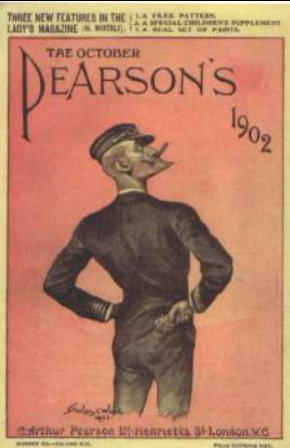
Pearson’s Magazine was a monthly publication founded by the English publisher Cyril Arthur Pearson (1866–1921), published from 1896 until 1939; an American version was launched in 1899,[1] but ceased publication in 1925.[2] Initially priced at sixpence,[a]2½p in decimal currency. the cost rose gradually to a shilling by 1918.[3] The magazine made history by being the first British periodical to publish a crossword puzzle, in February 1922.[4][b]The Daily Telegraph was the first newspaper to include a daily crossword puzzle, in 1925.[5]
Unlike most of its competitors, each edition of the magazine featured a different portrait or illustration on its front cover, and the magazine made liberal use of coloured illustrations inside.[6] The magazine contained an eclectic mix of content, including readers’ contests, articles on self-improvement, on the rich and famous, and short stories and serials.[1] The first issue, with which Pearson himself was not entirely happy, opened with a feature on “Artists and Their Work”, a review of the work of recently prominent artists, which remained the lead feature in most issues for the following thirty years.[7] One of H. G. Wells’s best-known novels, The War of the Worlds, was serialised in the magazine from April to December 1897;[8] it was published in book form the following year.[9] The magazine also published the first Lord Peter Wimsey stories, by Dorothy L. Sayers.[10]
A significant factor in the magazine’s success, according to Pearson, was the fictional detective created by Cutcliffe Hyne, named Captain Kettle, who in his time was second only to Sherlock Holmes in his popularity with the reading public. Kettle appeared in almost every issue from 1897 until 1899, and remained a recurring character until well into the First World War.[11]
The birth of radio and television during the 1930s signalled the end for fiction magazines such as Pearson’s, and on the outbreak of the Second World War in 1939 it was merged with The Strand Magazine Monthly publication founded by George Newnes, published 1891–1950, credited with introducing the short story to a British audience..[3] According to the writer and researcher Mike Ashley:
Monthly publication founded by George Newnes, published 1891–1950, credited with introducing the short story to a British audience..[3] According to the writer and researcher Mike Ashley:
Editors
Pearson claimed to be the magazine’s editor for the first four years of its existence, but the day-to-day management was carried out by Percy Everett, his editorial director.[12]
- Cyril Arthur Pearson (1896–1899)
- Percy W. Everett (1900–1911)
- Philip O’Farrell (1912–1919)
- John Reed Wade (January 1920 – April 1939)
- W. E. Johns (May 1939 – November 1939)
Notes
| a | 2½p in decimal currency. |
|---|---|
| b | The Daily Telegraph was the first newspaper to include a daily crossword puzzle, in 1925.[5] |
